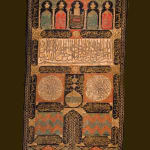Colour Sitara of Kaaba, 1767 CE - 1768 CE
Textile
DC.5821
Further images
-
(View a larger image of thumbnail 1
)

-
(View a larger image of thumbnail 2
)

-
(View a larger image of thumbnail 3
)

-
(View a larger image of thumbnail 4
)

-
(View a larger image of thumbnail 5
)

-
(View a larger image of thumbnail 6
)

-
(View a larger image of thumbnail 7
)

-
(View a larger image of thumbnail 8
)

-
(View a larger image of thumbnail 9
)

This magnificent work is an external curtain made to cover the door of the Kaaba (Burqa), one of Islam’s holiest sites. It was commissioned in 1181 Hijrah by Sultan Selim...
This magnificent work is an external curtain made to cover the door of the Kaaba (Burqa), one of Islam’s holiest sites. It was commissioned in 1181 Hijrah by Sultan Selim III (1761-1808) known for his reforms of the state system as well as for his love of music, poetry, and the arts. It was the custom for whoever ruled Egypt to create over a period of one year a beautiful curtain for the door of the Kaaba in Mecca. Using gold and silver thread, the artisans quoted certain passages from the Qur’an. Each Sitara carried the monogram of the ruler who commissioned such an extraordinary work.
The piece is made of black silk in a rectangular format and richly embroidered with gold and silver thread. There is a slit in the middle of the lower part in order to facilitate entry through the door of the Kaaba. The design of the embroidery can be divided into approximately eleven horizontal tiers of different sizes. The inscribed calligraphy, written mostly in the Thuluth Script, contains various verses from the Holy Qur’an, in addition to the Shahada and is contained within various geometric shapes. Additionally, a central inscription incorporates the name of the Sultan who commissioned the work and the year of the Hijrah calendar in which it was made. The borders as well as much of the background is richly decorated with foliage motifs in gold with a red and green silk background. There is also a frieze of stylized palm trees in the lower border of the curtain.
This Sitara is not only aesthetically beautiful but holds immense spiritual significance. It is a religious relic that breathes the history, culture, and magnificence of Islam.
The piece is made of black silk in a rectangular format and richly embroidered with gold and silver thread. There is a slit in the middle of the lower part in order to facilitate entry through the door of the Kaaba. The design of the embroidery can be divided into approximately eleven horizontal tiers of different sizes. The inscribed calligraphy, written mostly in the Thuluth Script, contains various verses from the Holy Qur’an, in addition to the Shahada and is contained within various geometric shapes. Additionally, a central inscription incorporates the name of the Sultan who commissioned the work and the year of the Hijrah calendar in which it was made. The borders as well as much of the background is richly decorated with foliage motifs in gold with a red and green silk background. There is also a frieze of stylized palm trees in the lower border of the curtain.
This Sitara is not only aesthetically beautiful but holds immense spiritual significance. It is a religious relic that breathes the history, culture, and magnificence of Islam.








